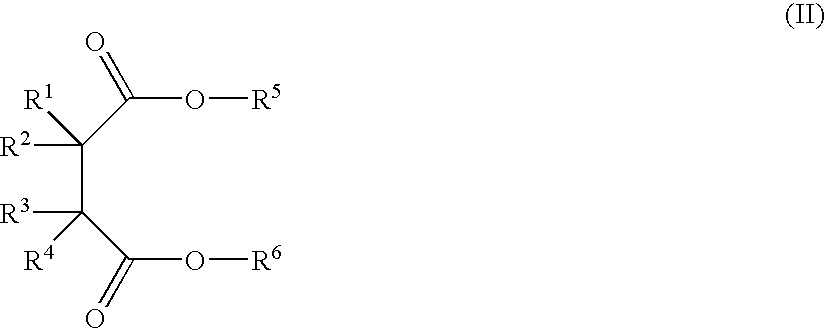Catalyst composition for the copolymerization of propylene
a technology of propylene and catalyst, applied in the direction of catalyst activation/preparation, physical/chemical process catalyst, chemical/physical process, etc., can solve the problems of limited processability, increased production cost, and difficulty in achieving the effect of improving the combination of properties and processability
- Summary
- Abstract
- Description
- Claims
- Application Information
AI Technical Summary
Benefits of technology
Problems solved by technology
Method used
Image
Examples
Embodiment Construction
[0015]For easier understanding the terms “diether catalyst” and “succinate catalyst” are used to denote a Ziegler-Natta catalyst with a diether compound as internal electron donor resp. a Ziegler-Natta catalyst with a succinate compound as internal electron donor.
[0016]The propylene polymers of the present invention can be copolymers of propylene and one or more comonomers, which can be ethylene or a C4-C20 alpha-olefin. The copolymers can be random copolymers or heterophasic copolymers.
[0017]The random copolymers of the present invention comprise at least 0.1 wt % of comonomer(s), preferably at least 0.2 wt %, more preferably at least 0.5 wt %, even more preferably at least 1 wt %, and most preferably at least 2 wt %. They comprise up to 10 wt % of comonomer(s), preferably up to 8 wt %, and most preferably up to 6 wt %. Preferably, the random copolymers are copolymers of propylene and ethylene.
[0018]The heterophasic copolymers of the present invention comprise a matrix, which in tu...
PUM
| Property | Measurement | Unit |
|---|---|---|
| weight ratio | aaaaa | aaaaa |
| weight ratio | aaaaa | aaaaa |
| weight ratio | aaaaa | aaaaa |
Abstract
Description
Claims
Application Information
 Login to View More
Login to View More - R&D
- Intellectual Property
- Life Sciences
- Materials
- Tech Scout
- Unparalleled Data Quality
- Higher Quality Content
- 60% Fewer Hallucinations
Browse by: Latest US Patents, China's latest patents, Technical Efficacy Thesaurus, Application Domain, Technology Topic, Popular Technical Reports.
© 2025 PatSnap. All rights reserved.Legal|Privacy policy|Modern Slavery Act Transparency Statement|Sitemap|About US| Contact US: help@patsnap.com

